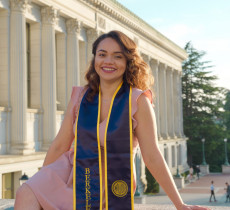CRD's Silvia Miramontes: Merging Applied Math and Machine Learning for Science
September 29, 2020
Contact: cscomms@lbl.gov
When Silvia Miramontes – one of the newest computer systems engineers in Berkeley Lab’s Computational Research Division – visualizes something, it tends to materialize.
Raised in Tijuana, Mexico, Miramontes spent her junior and senior years of high school in San Diego, Calif. After graduating she went on to community college, then transferred to UC Berkeley to finish her four-year degree, earning a bachelor’s in 2018 in applied mathematics with an emphasis in data science – and making her a first-generation graduate in her family.
Miramontes’ move to Berkeley opened up other opportunities as well. Toward the end of her second year at Cal she became a research affiliate at Berkeley Lab in the Data Analytics and Visualization (DAV) group under Dani Ushizima. In 2019, she again got to work with Ushizima and the DAV group through the Science Undergraduate Laboratory Internships program. Later that year, she was accepted into UC Berkeley's 5th Year Master's in Information and Data Science (MIDS) program in the School of Information (I School), where she was able to continue working in CRD, applying convolutional neural network-based methods to the study of ceramic matrix composites – a research project that resulted in a publication in Springer’s Lecture Notes from Computer Science: Advances in Visual Computing and a poster at SC19.
“What got me into machine learning initially was the application of math to various problems, which is actually what got me into math in the first place,” she said. “And even though I had to understand the theory behind the applications, I was well aware that sometimes you have to get through the hurdles to get to the fun things.”
To cap what has already been a busy few years, this summer Miramontes and a team of I School colleagues – Emma Russon, Isa Chau, J.J. Sahabu, and Chelsea Shu – won the Databricks 5th Year MIDS Capstone Award for the development of Gredient, an iOS application hosted in Amazon Web Services that uses optical character recognition to help users check for allergens in food product labels. (The application is not yet available for download.)
“This award summarizes the kind of work we can do as graduates from the I School. While technically heavy, it is the perfect example of the ethical utilization of data science methods to better the lives of many,” she said. “We wanted to foster this application for people who are trying to avoid certain ingredients and provide the public with something that is easy to use. Often the ingredient label’s font is very small, so if the user doesn’t have great vision the labels can be really hard to read.”
Gredient also incorporates some of the work Miramontes has been focusing on for the last few years at Berkeley Lab – with a twist.
“Throughout my research projects and the publications I’ve done with Dani, I’ve been working in computer vision for the detection of objects in scientific images,” she said. “What was new to me here was that rather than detecting an object – whether it was a cell or a fiber – I had to learn about the neural networks used to read words off of an ingredient label. That was where the optical character recognition came in.”
Miramontes has her sights set on a Ph.D., but for the time being she is happy working in CRD’s CAMERA group, focusing on the processing of scientific 2D and 3D imagery and the application of machine learning algorithms to detect and classify objects, material phases, and cells. She particularly likes the camaraderie of the group and the Lab and the many opportunities for collaboration. In the long run, she sees herself as a data scientist researcher working in academia or a national laboratory for these same reasons – plus the opportunity to continue contributing to the acceleration of scientific processes.
“I want to continue with the application of deep learning methods to various disciplines, but my heart is in biomedical research,” she said. “During my very first project with Dani, it dawned on me how the development of these technologies are the key attributes to the evolution of biomedical and energy research. Which, in turn, innovates the scientific community."
She has some words of wisdom for other young scientists as well.
“As a future scientist, if anyone reading this is starting as a Berkeley Lab affiliate or community college intern and is eager to pursue a career as a researcher, I want you to know that with hard work and dedication, your goals are definitely achievable,” she said. “There may be some moments of doubt, but persist – in the end, your efforts will pay off.”
About Berkeley Lab
Founded in 1931 on the belief that the biggest scientific challenges are best addressed by teams, Lawrence Berkeley National Laboratory and its scientists have been recognized with 16 Nobel Prizes. Today, Berkeley Lab researchers develop sustainable energy and environmental solutions, create useful new materials, advance the frontiers of computing, and probe the mysteries of life, matter, and the universe. Scientists from around the world rely on the Lab’s facilities for their own discovery science. Berkeley Lab is a multiprogram national laboratory, managed by the University of California for the U.S. Department of Energy’s Office of Science.
DOE’s Office of Science is the single largest supporter of basic research in the physical sciences in the United States, and is working to address some of the most pressing challenges of our time. For more information, please visit energy.gov/science.










